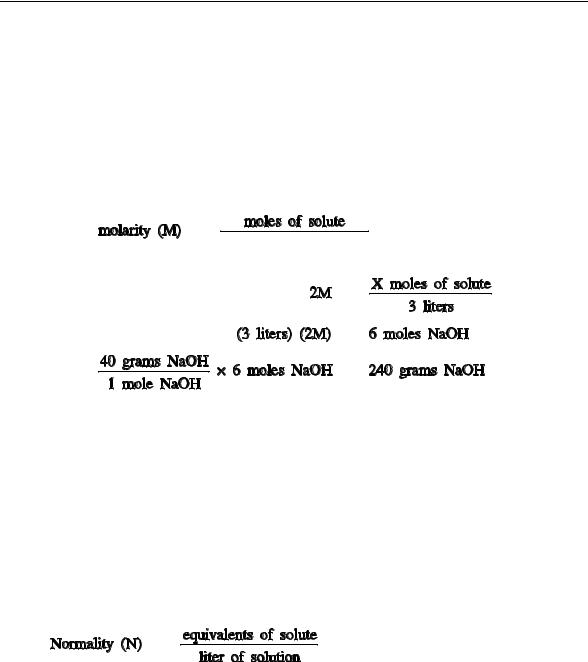
- •ABSTRACT
- •FOREWORD
- •OVERVIEW
- •TABLE OF CONTENTS
- •LIST OF FIGURES
- •LIST OF TABLES
- •REFERENCES
- •OBJECTIVES
- •CHARACTERISTICS OF ATOMS
- •Characteristics of Matter
- •The Atom Structure
- •Chemical Elements
- •Molecules
- •Avogadro's Number
- •The Mole
- •Mole of Molecules
- •Summary
- •THE PERIODIC TABLE
- •Periodic Table
- •Classes of the Periodic Table
- •Group Characteristics
- •Atomic Structure of Electrons
- •Summary
- •CHEMICAL BONDING
- •Chemical Bonding
- •Ionic Bonds
- •Covalent Bonds
- •Metallic Bonds
- •Van der Waals Forces
- •Organic Chemistry
- •Alkanes
- •Alkenes
- •Alkynes
- •Aromatics
- •Alcohols
- •Aldehydes
- •Basic Chemical Laws
- •Forming Chemical Compounds
- •Combining Elements
- •Summary
- •CHEMICAL EQUATIONS
- •Le Chatelier's Principle
- •Density
- •Molarity
- •Normality
- •Parts per Million
- •Chemical Equations
- •Balancing Chemical Equations
- •Summary
- •ACIDS, BASES, SALTS, AND pH
- •Acids
- •Bases
- •Salts
- •Dissociation Constant
- •Summary
- •Introduction
- •Isotopic Separation
- •Separation Factor
- •Stage Separation
- •Barrier Measurements
- •Cascade Theory
- •Circuit Balances
- •CONVERTERS
- •Converters
- •Converter Construction
- •The Gas Cooler
- •Barrier Tubing
- •Process Gas Flow
- •Diffusion
- •TABLE OF CONTENTS
- •LIST OF FIGURES
- •LIST OF TABLES
- •REFERENCES
- •OBJECTIVES
- •CORROSION THEORY
- •Corrosion
- •Electrochemical Cells
- •Oxidation-Reduction Reactions
- •Passivity and Polarization of Metal
- •Summary
- •GENERAL CORROSION
- •Conditions Contributing to General Corrosion
- •Corrosion of Iron
- •Factors Affecting General Corrosion Rate
- •Prevention Chemistry Control
- •Corrosion of Aluminum
- •Summary
- •CRUD AND GALVANIC CORROSION
- •Crud
- •Galvanic Corrosion
- •Prevention of Galvanic Corrosion
- •Summary
- •SPECIALIZED CORROSION
- •Pitting and Crevice Corrosion
- •Stress Corrosion Cracking
- •Summary

CHEMICAL EQUATIONS |
DOE-HDBK-1015/1-93 |
Fundamentals of Chemistry |
|
|
|
CHEMICAL EQUATIONS
This chapter will discuss the methods of qualifying solutions. The balancing of the chemical equations will also be explained in this chapter.
EO 2.7 STATE Le Chatelier's principle.
EO 2.8 DEFINE the following terms:
a. |
ppm |
c. |
Density |
b. |
Molarity |
d. |
Normality |
EO 2.9 BALANCE chemical equations that combine elements and/or compounds.
Le Chatelier's Principle
The effect of temperature on solubility can be explained on the basis of Le Chatelier's Principle. Le Chatelier's Principle states that if a stress (for example, heat, pressure, concentration of one reactant) is applied to an equilibrium, the system will adjust, if possible, to minimize the effect of the stress. This principle is of value in predicting how much a system will respond to a change in external conditions. Consider the case where the solubility process is endothermic (heat added).
solid  heat
heat  solution
solution
An increase in temperature puts a stress on the equilibrium condition and causes it to shift to the right. The stress is relieved because the dissolving process consumes some of the heat. Therefore, the solubility (concentration) increases with an increase in temperature. If the process is exothermic (heat given off).
solid  solution
solution  heat
heat
A temperature rise will decrease the solubility by shifting the equilibrium to the left.
How much solute is dissolved in a solution is very important when the solution is being made for a specific use. To say there is a little, a lot, or a bit would not be very accurate if a specific concentration is required. There are a few common and accurate methods used to express concentration. These are density, molarity, normality, and parts per million.
CH-01 |
Page 36 |
Rev. 0 |

Fundamentals of Chemistry |
DOE-HDBK-1015/1-93 |
CHEMICAL EQUATIONS |
|
|
|
Density
Density is the measure of the mass per unit volume of a material (density = mass/volume). Density is a characteristic of a substance; mass and volume are not. Mass and volume vary with size but density will remain constant. Temperature will affect the density of a substance and the temperature at which density for that substance was determined is usually reported along with the density value.
Molarity
A useful way to express exact concentrations of solutions is molarity. Molarity is defined as moles of solute per liter of solution. Molarity is symbolized by the capital letter M. It can be expressed mathematically as follows.
moles of solute (n) molarity (M) 


liters of solution (V)
Notice that the moles of solute are divided by the liters of solution not solvent. One liter of one molar solution will consist of one mole of solute plus enough solvent to make a final volume of one liter.
Example 1:
Prepare one molar solution of NaCl.
Solution:
a)Calculate the molecular weight of the salt
1 |
atom of Na |
22.989 |
amu |
1 |
atom of Cl |
35.453 |
amu |
1 molecule of NaCl |
58.442 amu |
||
One mole is equal to the gram molecular weight, so one mole = 58.442 grams.
b)58.442 grams of NaCl is weighed out and sufficient water is added to bring the solution to one liter.
Rev. 0 |
Page 37 |
CH-01 |

CHEMICAL EQUATIONS |
DOE-HDBK-1015/1-93 |
Fundamentals of Chemistry |
|
|
|
Example 2:
Prepare 3 liters of a 2M NaOH solution.
Solution:
Calculate the amount of NaOH required to prepare the solution.
a) |
|












 5
5
b) |
substituting: |
|
Therefore, to prepare 3 liters of a 2M NaOH solution, 240 grams of NaOH must be weighed out and dissolved in water to make a volume of exactly 3 liters.
Normality
The normal concentration is another method for expressing the concentration of solutions. Normality (N) is defined as the number of equivalents of solute dissolved in one liter of solution.
One equivalent of acid is the amount of acid necessary to give up one mole of hydrogen ions in a chemical reaction. One equivalent of base is the amount of base that reacts with one mole of hydrogen ions. When expressing the concentrations of bases, normality refers to the number of available hydroxyl ions. Because hydrogen and hydroxyl ions combine on a one-to-one basis, one OH- is equivalent to one H+ ion.
a) |
H+Cl- |
|
+ |
Na+OH- |
|
Na+Cl- |
+ |
H+OH- |
|
|
Acid |
|
|
Base |
|
Salt |
|
|
Water |
b) |
H SO |
4 |
+ |
2K+OH- |
|
K SO |
4 |
+ |
2H+OH- |
|
2 |
|
Base |
|
2 |
|
Water |
||
|
Acid |
|
|
|
Salt |
|
|
||
|
|
|
|
|
|
|
|
|
|
CH-01 |
Page 38 |
Rev. 0 |

Fundamentals of Chemistry |
DOE-HDBK-1015/1-93 |
CHEMICAL EQUATIONS |
|
|
|
Notice that in reaction a), one mole of HCl yields one equivalent per mole or one mole of H+ ions. H2SO4 has two equivalents per mole or two H+ ions because each mole of the compound can release two moles of hydrogen ions.
The number of equivalents of an acid or base can be determined from equivalent weight. The equivalent weight is defined as the molecular weight of the acid or base divided by the number of replaceable hydrogen or hydroxyl ions.
Example:
The equivalent weight of H2SO4 is:











 .
.

This means 49 grams of H2SO4 is equal to one equivalent of H2SO4. If there is a one liter solution that contains 78.32 grams H2SO4, the number of equivalents is:
|
. |
Since normality is equal to the number of equivalents per liter, the normality of this solution is 1.6 equivalents/liter, or 1.6 N.
Parts per Million
Another term used to describe the specific concentration of a solution is parts per million or ppm. The term ppm is defined as the concentration of a solution in units of one part of solute to one million parts solvent. One ppm equals one milligram of solute per liter of solution. Another term, parts per billion (ppb), is defined as one part solute per one billion parts solvent. One ppb is equal to one microgram solute per liter of solution. These two terms are usually used for very dilute solutions.
Rev. 0 |
Page 39 |
CH-01 |
